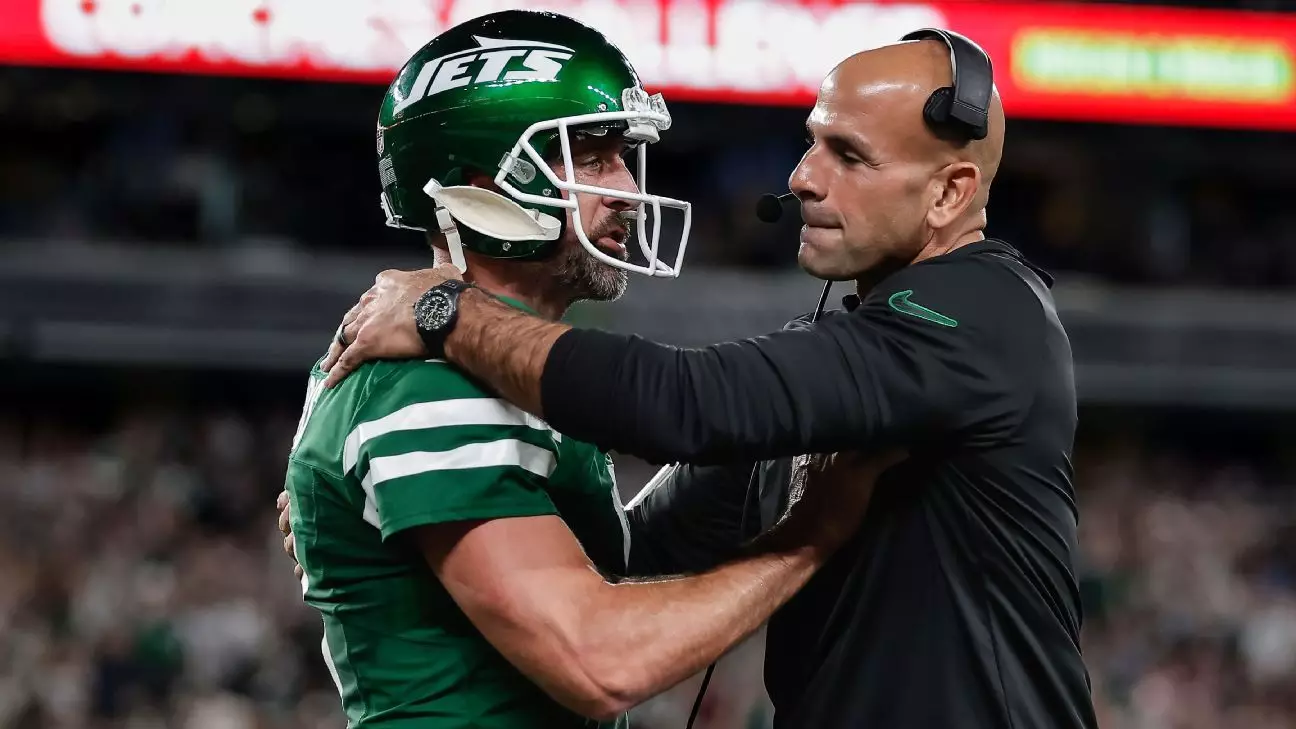In a captivating showdown at MetLife Stadium, the New York Jets showcased their prowess against the New England Patriots, clinching a decisive 24-3 victory. Quarterback Aaron Rodgers significantly contributed to this outcome with a stellar performance, passing for 281 yards and two touchdowns. His dynamic playmaking abilities and resilience were on full display, but it was an unexpected moment with his head coach Robert Saleh that stole the spotlight. This article delves into the multifaceted aspects of Rodgers‘ performance and its implications for the team moving forward.
At 40 years old and fresh off an Achilles injury, many doubted whether Rodgers could reclaim his former glory. However, against the Patriots, he demonstrated that age is merely a number. Completing 27 out of 35 passes, Rodgers became the fourth quarterback in NFL history to maintain a completion rate of 75% while amassing over 250 yards at this age, a feat previously accomplished by legends like Tom Brady and Drew Brees. The significance of this milestone resonates deeply within the football community, showcasing not only his skill but also his determination to excel despite physical setbacks.
Rodgers exhibited remarkable mobility and vision during the game. After a couple of lackluster performances regarding mobility, he demonstrated agility that many thought was behind him. Rodgers was particularly effective outside the pocket, completing all six of his throws for 88 yards in such situations. His ability to evade pressure and deliver accurate passes underscores the lasting quality of his football intelligence and skill set, elements that remain intact despite the challenges of aging.
Interestingly, amid Rodgers‘ standout performance, a seemingly innocuous moment with Coach Saleh became a talking point on social media. When the Jets surged to a 14-0 lead, Saleh approached Rodgers for what appeared to be a congratulatory hug. Instead, the quarterback gently pushed him away and showcased body language that suggested premature celebration was unwarranted.
Both men later attempted to downplay the incident in their post-game interviews, but it reflects an interesting dynamic between a veteran player accustomed to championship pressures and a young head coach still establishing his identity in the NFL. This moment of camaraderie—or lack thereof—indicates a deeper layer of expectations that athletes carry, particularly when trying to maintain focus in competitive environments. Saleh’s desire to celebrate speaks to the optimism of the Jets‘ season, while Rodgers‘ reticence mirrors a mindset rooted in the pursuit of excellence rather than complacency.
The Jets executed their game plan with precision, dictating the pace of the game against the Patriots. Rodgers directed multiple impressive drives, spanning 73, 91, and 66 yards, contributing to their offensive dominance. This capability to convert sustained drives into touchdowns highlights a collaborative execution involving not just Rodgers but also a diverse range of receivers. Eight different pass-catchers contributed to the offensive efforts, demonstrating the Jets‘ versatility and commitment to distributing the ball effectively.
The connection between Rodgers and Garrett Wilson was particularly notable. Following a previous incomplete pass, Rodgers showcased his adaptability and trust in Wilson, connecting for a touchdown that not only solidified the lead but also ended Wilson’s eight-game scoring drought. Such moments illustrate how collaboration and communication flourish on the field, even amidst pressures of the game.
One cannot overlook the emotional atmosphere permeating the stadium that night. The Jets fans displayed their unwavering support for Rodgers, evident when they erupted into chants of his name by the third quarter. The context of his return to MetLife, a location synonymous with both triumph and torment—given his Achilles injury last season—adds a layered emotional element to his performance.
Players like Allen Lazard recognized the significance of this moment as well, as he personally handed the game ball to Rodgers in acknowledgment of the night’s special circumstances. This gesture signified not only respect but also camaraderie within the team, key components to a successful season. Celebrating small victories like this can often ignite the larger framework of a team’s culture.
Rodgers‘ performance against the Patriots was more than just a statistical triumph; it represented a resurgence of spirit for both the player and the Jets‘ organization. As the Jets build momentum with a solid 2-1 record, this victory serves as a pivotal marker for what lies ahead. With Rodgers demonstrating resilience, skill, and an evolving rapport with his coach and teammates, the Jets could indeed be on the cusp of something great. As the NFL season progresses, the dual narratives of individual accomplishment and team dynamics will be critical to their aspirations for success.


Napsat komentář